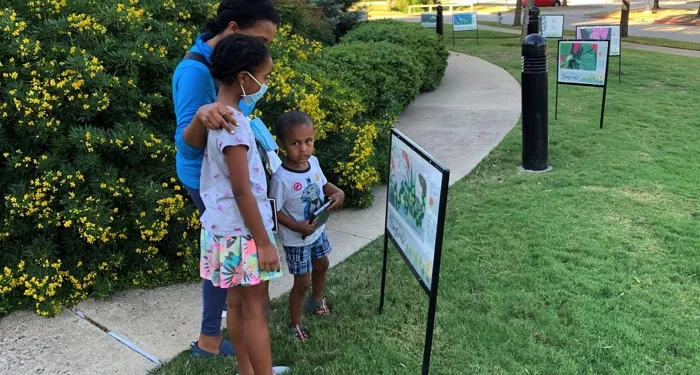
Literacy Among The Leaves: Everything You Want To Know About StoryWalks
What is a StoryWalk?
A StoryWalk is a movement and literacy boosting project that places an illustrated children’s book, taken apart and displayed page by page, along a walking route in your community. Anne Ferguson, the genius behind the StoryWalk concept, sums it up nicely with these sentences, which she asks to be posted when creating your own StoryWalk: “The StoryWalk® Project was created by Anne Ferguson of Montpelier, VT and developed in collaboration with the Kellogg-Hubbard Library. Storywalk® is a registered service mark owned by Ms. Ferguson.”

When Anne Ferguson was working with the Vermont Department of Health, she created The StoryWalk® Project as a way to convince families to get outside and be active while engaging with literacy. She was on the hunt to create something that required the adults to be active alongside children, with no financial limitations that would leave some families out. StoryWalk was born.
What does this actually look like? The creator literally takes a book apart and displays it outside, one page at a time, in the correct order. Ms. Ferguson shares tips for her preferred supplies in the StoryWalk FAQ, but I have seen StoryWalks displayed in a variety of ways. From pages attached to fences to fancy podium-style boxes with plexiglass lids, the possibilities are vast, but the outcome is the same: people are encouraged to continue walking to find the next page of the book. There is literacy, there is nature, there is movement. Win, win, win.
Where do you put a StoryWalk?
The original goal for The StoryWalk Project was to have stories placed outside in nature. Public walking trails are a natural and obvious place to start, but the project has expanded to include city settings such as main street businesses and school playgrounds. If you consider that the aim is to have families moving outside, any safe route that lets you space out pages can be used. In my city, I’ve spotted books spaced along the walking trail that circles a local pond, and around the circumference of our city-owned working apple orchard.
There are, of course, practical considerations that need to be addressed. Spaces that take a hard hit from the elements (super high winds, for example) are not ideal. Anne Ferguson hilariously shares these tips for avoiding damage caused by humans in her StoryWalk History: “Vandals are a recurring challenge. They seem to be threatened by a story about Gossie, a small duck who has misplaced his red rubber boots. A range of approaches has been used to address this issue, some with greater success than others. The Velcro® makes it easy to take down the pages before dark and post them again in the morning. Vandals prefer the cover of darkness.”
How do you make a StoryWalk?
The creation of a StoryWalk is deceptively easy, but there are some particulars that make all the difference in success rates. Copyright laws allow you to use existing books you have purchased, but you cannot enlarge or alter the text in any way, so the move is to carefully dismantle the book itself. After you have your pages, they need to be backed on something stiff (card stock is a favorite) and, most importantly, laminated. Anne Ferguson, in her StoryWalk FAQ page, gives amazing detail into how she prepares books to be displayed. A wide margin of laminate and extremely strong velcro seem to be key components.
What books are good for a StoryWalk?
There is a lot to consider when choosing a title. It’s important to have engaging illustrations and pages that don’t include too much text. A plot-driven story that will motivate the families to find the next page is extremely helpful. Different communities and even areas within your community might have different literacy needs, including languages spoken and messages conveyed.
There are a few instances in the Northeastern U.S. of StoryWalk libraries, where community organizations can borrow titles already prepared for StoryWalk. The Massachusetts Department of Early Education and Care has five resource centers with StoryWalk books available. Anne Ferguson herself has a collection of books available to borrow for up to two weeks, which are let through the Kellogg-Hubbard Library in Montpelier, Vermont.
Looking to install a StoryWalk in your community?
- Start with your basics. Who will be paying for this? Who will be in charge of routine upkeep? Once you have these details, it’ll be easier to get others onboard. Great places to look for partners include your public library or your local recreation department. Boston Children’s Museum has an amazing, in-depth brochure that includes extensive how-tos on sponsoring a StoryWalk, as well research into early literacy and the benefits of StoryWalks, which could be helpful in making your pitch. Check out the brochure, titled Take A Hike! Building Literacy Skills Through StoryWalk, here.
- Next, choose the venue. This is where conversations with local officials and stakeholders can really help. Will this be deep in nature or along a well-traveled sidewalk? Target audience, time of year, and community support will all play into this decision.
- Now, decide on your method of display. If you’re on a walking trail, you might go with stakes and Velcro. If you’re in a city space, store windows might be the move. Your budget, venue, and ability to commit to routine upkeep will help you decide which display method will work best.
- Finally, you choose a title! Keep in mind things such as the languages spoken by the people who travel this route, manageable text length, and engaging illustrations. You might decide to outsource and borrow a title already prepared from one of the libraries of StoryWalk books, or create your own using a book specially chosen for your community.
Hopefully you’ve found some tips to help you better understand StoryWalks, and maybe even been inspired to sponsor one of your own!









